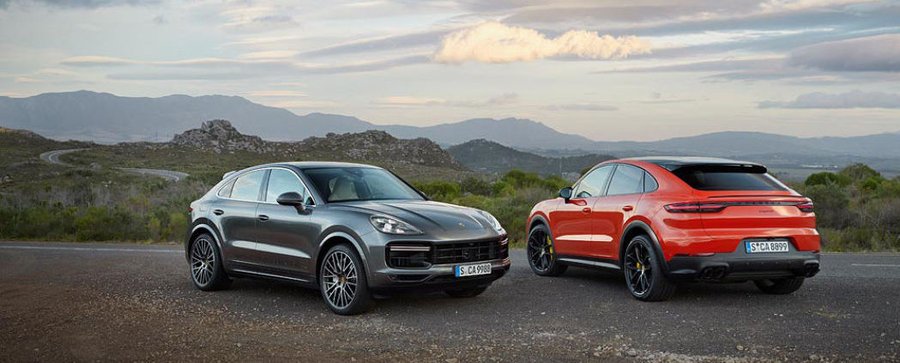2020 Porsche Cayenne Coupe debuts with sporty looks but reduced utility

Porsche is officially jumping on the slantback bandwagon with the 2020 Cayenne Coupe. In nearly every technical aspect, the Coupe is one and the same with the normal Cayenne. The difference is mostly visual. A steep roof line falls away into an angled rear window, similar to the Audi Q8. Porsche claims this makes the car appear "more dynamic, and positions it as the sportiest-looking model in the segment."
The roof edge is exactly 0.78 inch lower than the standard Cayenne. This sporty look comes at the expense of utility, just like every other slanted roof SUV out there. This kind of styling looks more at-home in a Porsche than some of the brand's competitors. To make the whole look work well as a whole, Porsche redesigned the rear doors and quarter panels. This ended up making it a hair wider than the normal Cayenne, appearing more squat in photos.
Base Cayenne Coupes adopt the same 3.0-liter turbocharged V6 found in the regular Cayenne that 335 horsepower and 332 pound-feet of torque. This one gets to 60 mph in 5.7 seconds, or 5.6 seconds after adding the optional lightweight sports packages. The Cayenne Turbo Coupe uses the 4.0-liter twin-turbo V8 producing 541 horsepower and 567 pound-feet of torque, bringing the 0-60 mph time down to 3.7 seconds. Porsche makes the Sport Chrono package standard equipment on the Coupe — compared to an equivalent Cayenne, the 0-60 time for the Coupe is identical, assuming you opt for the lightweight sports package on the base model. The Turbo models are the same without any exceptions. Other additional standard equipment on the Coupe includes Porsche Active Suspension Management (PASM) and 20-inch wheels — these are cost options you'll need to tack on to the normal Cayenne.
Another cool feature the Coupe steals from the normal Cayenne is its adaptive rear spoiler. This was standard on the Turbo Cayenne, but appears on both models of the Coupe. It extends by 5.3 inches above speeds of 56 mph. A fixed panoramic glass roof with a shade is standard equipment, but Porsche is introducing a carbon fiber roof option exclusively for the Coupe that looks pretty rad. It's a part of three separate lightweight sports packages that include 22-inch GT design wheels, fabric seat centers in Pepita (we'll call it Houndstooth, because it's close enough) along with carbon fiber and Alcantara accents in the interior. A Sport Exhaust system is also available for the Turbo.
Porsche designed 8-way adjustable seats with more bolstering to fit the car's sportier nature. Rear seat passengers sit 1.18 inches lower than in the normal Cayenne to ensure their heads don't bump into the tapering ceiling. This leads us into discussing the downsides of this bodystyle. Porsche quotes cargo volume as being down to just 22 cubic feet for the Coupe, compared to 27.2 cu-ft for the normal Cayenne. With the second row down it grows to 54.3 cu-ft, which is still less than the 60.3 cu-ft of the non-Coupe Cayenne. Those numbers aren't good for folks looking to cram a lot of stuff into their Porsche, but we wouldn't call it crippling. The 22 cu-ft is still larger than the Panamera's 17.6 cu-ft.
Just as the Q8 is to the Q7, Porsche is making the Coupe more expensive than the traditional SUV. A base Cayenne costs $66,950, but the Cayenne Coupe starts at $76,550 after the $1,250 delivery fee for both. The Turbo Coupe goes up from $131,350, which is actually less of a premium than the base car is over its equivalent. If you were to tack on the additional standard equipment (PASM, Sport Chrono) from the Coupe onto the normal Cayenne, the price difference narrows to about a $4,000 gap.
